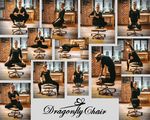Natural active sitting with Dragonfly chair
It is well known that prolonged sitting, standing or even lying down is not healthy. Life is creation intermingled with rest; it goes on in balance. After a night's rest, we should be active to support the constant movement and life going on inside us. Unfortunately, sitting passively on a traditional chair with a back makes our muscles lazy, so the spine loses its support and begins to twist, the internal organs become anaemic and the pelvic muscles become contracted. Therefore, the solution must be sought in active sitting in a variety of relaxed and stretching positions, as primitive humans sat on the ground and we as children sat on the floor.
In order to maintain full mobility of our body, it is necessary to assume various positions so that the joints have the possibility to move in every direction. According to the principle what is not used, begins to disappear - if we do not use the full range of motion of individual joints then at some point, we limit their mobility.
Sitting on the floor, children twist in all sorts of ways so that the joints of the knees, feet and hips have a full range of movement and the body maintains its flexibility. The lack of support helps to strengthen the muscles that hold up the spine. Stiffness and limitations only appear when we remain in one position all day. So, the message from school "don't wriggle, sit up straight" needs to be quickly erased from your memory and you should start wriggling as much as possible at will, the more the better. The author of the book "Sentenced to a desk" even indicates that the seat should be hard and not very comfortable, so that it encourages frequent change of position. In addition, sitting in low positions is the best of all possible ways of sitting, because as many as two pillars provide support: the hips and the torso, and not just the back of the thighs as in a traditional chair.
Cross-legged ("Turkish") sit:
- introduces an element of rotation in the positioning of the hips, thus stabilising the pelvis;
- relaxes and improves body flexibility;
- strengthens back and abdominal muscles;
- opens the hips;
- increases mobility in the hip joints (which prevents their dysplasia in the future). The hips are a complex joint connecting the top of our body to the bottom - the spine to the pelvis and the pelvis to the legs. Stiffness in the hips can cause pain in the spine, knees, feet, as well as the neck and shoulders, causing headaches. The hips are also a key point for the flow of blood and lymph through our body, by relaxing them you improve the blood supply to the cells throughout the body and also improve the process of removing toxins from the body. From an energetic point of view, the pelvis is the seat of our power - the power of creative, joyful, uninhibited, spontaneous creation, and the transit point for all the major meridians. We should therefore ensure that the flow through it is unrestricted.
- it increases oxygenation of the body by straightening the spine and stretching the muscles;
- it regulates blood pressure by lowering it through raising the legs to hip height;
- calms the mind (best position for meditation).
It is interesting to note that, as parents, we take great care of the hip joints of our babies by keeping them used most of the time, by for example, "wide diapering" or carrying them on the hip with their legs positioned wide apart. And when the child is older, we suddenly forget about this and put them in a traditional chair, where opening the hips becomes very difficult. It seems that if we had stayed on this floor as children, there would have been fewer problems with the spine and hip and knee joints when we were older.
Kneeling down ("Japanese style"):
- encourages an upright posture, generates natural pressure forces in the spine (similar to standing);
- facilitates free breathing;
- has a relaxing effect on the feet.
Sitting in a squat, crouching:
- engages the whole lower limb;
- increases hip mobility;
- makes ankles more flexible;
- stretches buttocks;
- relieves back;
- improves posture;
- helps relax the overly tense pelvic floor, has a beneficial effect on intestinal peristalsis and helps to normalise abdominal pressure;
- moreover, it calms, grounds and improves concentration;
- the wide range of movement in this sit stimulates the joints to secrete synovium. Movement within the joints should often exceed 90 degrees so that degeneration does not occur.
In conclusion, sitting in low positions has accompanied us since the dawn of time and in these positions, we learn about the world during our first years of life. I think that nature does not make a mistake and tells us what is best for us.

Below you will find more information about Dragonfly chair from testing people perspective.
- Recenzja fizjoterapeuty Marka Purczyńskiego
- Opinia trenera personalnego, Alex z Athletic Development,
- Co o nas piszą na portalu "komputerświat"
- Dragonfly - test fotela dla biegacza - Przemysław Niemczuk (trening biegacza)
- Opinia fizjoterapeutki i joginki - Małgorzata Kobus-Kwiatkowska (Anatomia jogi)
- Opinia joginki i trenerki, Ola Żelazo
- Polecenie od ternerki Kasi Bigos


 Innovatronica Sp. z o. o.
ul. Prowansji 10F
05-509 Józefosław
Poland
Innovatronica Sp. z o. o.
ul. Prowansji 10F
05-509 Józefosław
Poland 